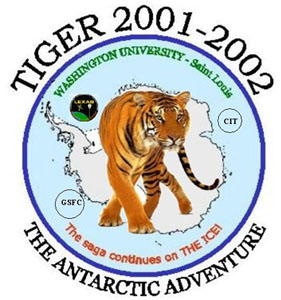Click on image for full size
Courtesy of NASA in collaboration with Washington University, Caltech and the University of Minnesota
TIGER's in Antarctica?
News story originally written on February 1, 2002
The TIGER instrument was launched on a helium-filled balloon on December 20, 2001. When it landed 31 days and 20 hours later on January 21, 2002, it had broken all records for long-duration balloon flights! The best record before this was 26 days set in January 2001.
"We are excited with the duration of this flight, which
allowed the scientists to get ample science to perform their
studies," said Steve Smith, Chief of the Balloon Program
Office at NASA Goddard Space Flight Center's. "We routinely have long-
duration balloons that float for up to two weeks, but to have
one flight last for over 31 days is very rewarding." The balloon carrying TIGER was launched from McMurdo Station, Antarctica. TIGER stands for the Trans-Iron Galactic Element Recorder experiment. The balloon rose to an altitude of approximately 125,000 feet (38,100 meters). The inflated balloon at this point was about 424 feet (129 meters) in diameter and over 555 feet high!
For the 31 days, the balloon permitted TIGER to search for the origin of galactic cosmic rays, atomic particles that travel
through the galaxy at near light-speeds and shower the Earth constantly. "The importance of TIGER is that it is the first experiment
that has both sufficient collecting power and adequate
resolution to measure abundances of all nuclei from iron
through zirconium," said TIGER Principal Investigator Robert
Binns, Washington University. "This will enable us
to determine whether the cosmic-ray source is hot or cold,
gas or solid. We have already seen in our quick-look analysis
of flight data that Tiger's resolution is sufficient to
resolve those nuclei."















